ULMS 353 - Strategic Report: Airbus Business Management & Policy
VerifiedAdded on 2023/06/13
|22
|5801
|164
Report
AI Summary
This strategic report provides a comprehensive analysis of Airbus, a leading aircraft manufacturing corporation, focusing on its business management and strategy. The report begins with an introduction to Airbus, outlining its background, target market (airline operators and government defence agencies), and the aerospace and defence industry it operates within. It assesses Airbus's current value-added strategy, highlighting its reliance on an empowered strategy team providing tailored solutions to customers. The report then delves into an external analysis using the PESTEL framework, examining political, economic, social, technological, environmental, and legal factors influencing the industry, including the impact of Brexit, jet fuel prices, and increasing air travel. Furthermore, Porter's Five Forces analysis is applied to evaluate the competitive landscape. The report concludes by summarizing the key external factors affecting Airbus's operations and strategic positioning.
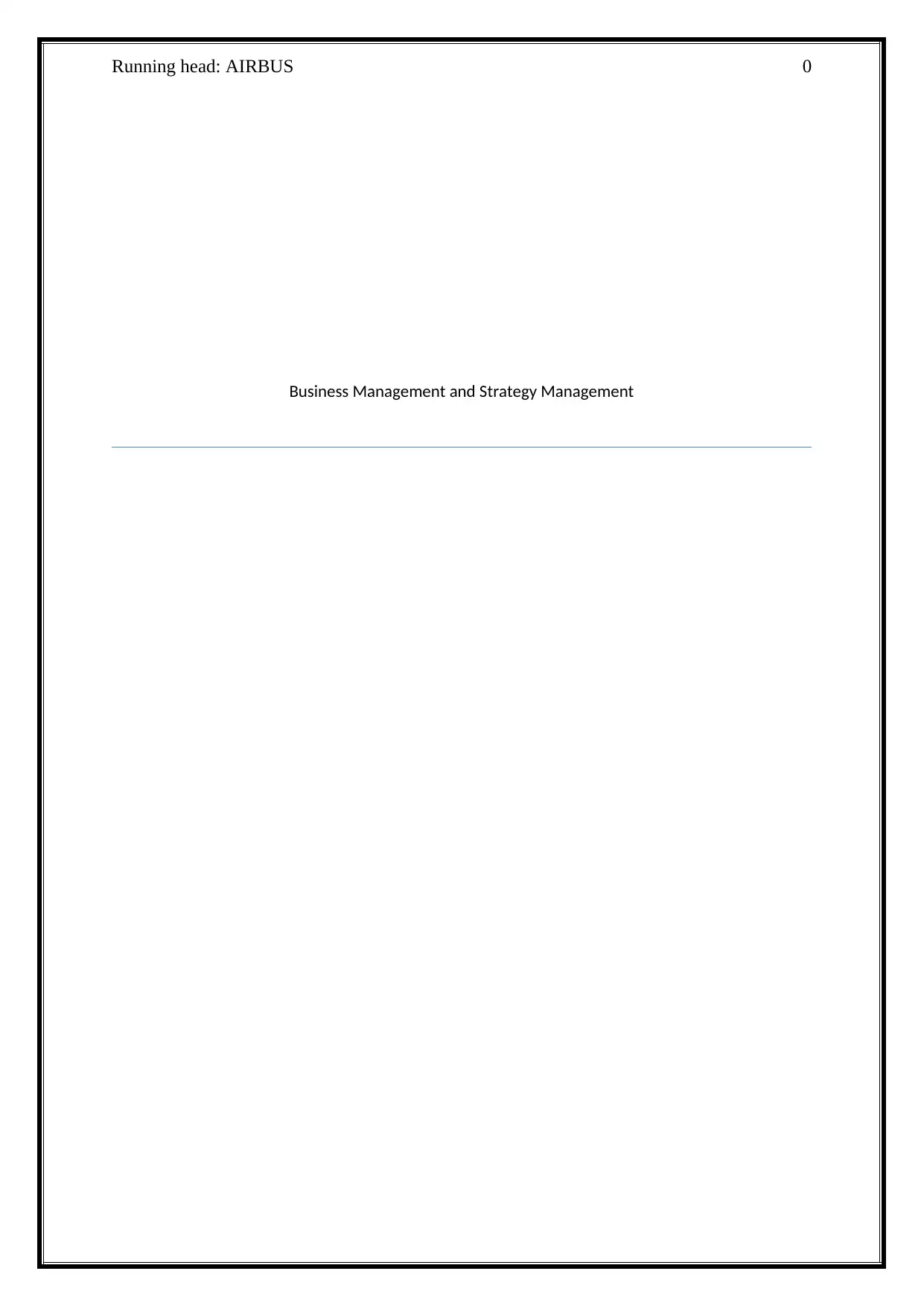
Running head: AIRBUS 0
Business Management and Strategy Management
Business Management and Strategy Management
Paraphrase This Document
Need a fresh take? Get an instant paraphrase of this document with our AI Paraphraser
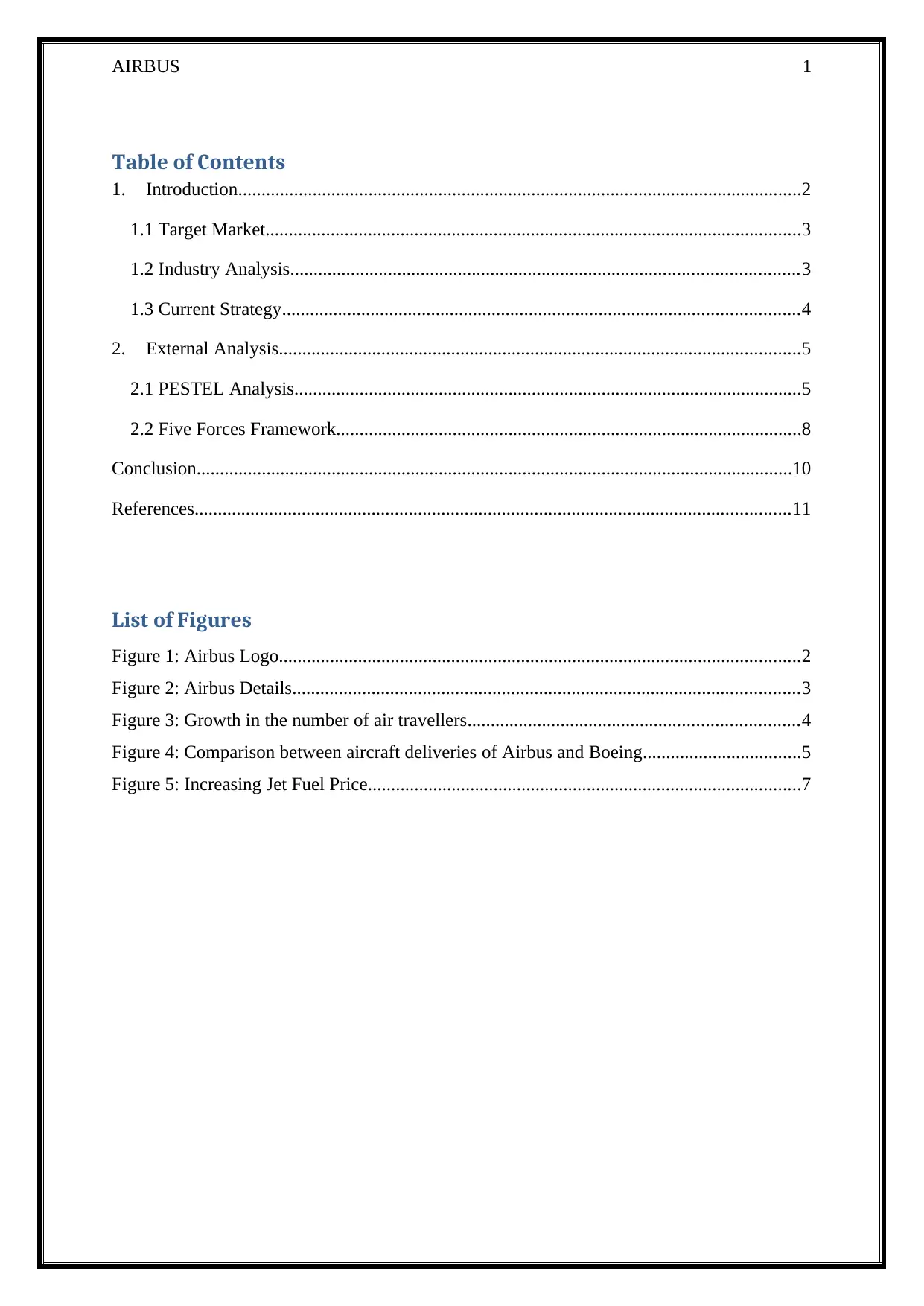
AIRBUS 1
Table of Contents
1. Introduction.........................................................................................................................2
1.1 Target Market...................................................................................................................3
1.2 Industry Analysis.............................................................................................................3
1.3 Current Strategy...............................................................................................................4
2. External Analysis................................................................................................................5
2.1 PESTEL Analysis.............................................................................................................5
2.2 Five Forces Framework....................................................................................................8
Conclusion................................................................................................................................10
References................................................................................................................................11
List of Figures
Figure 1: Airbus Logo................................................................................................................2
Figure 2: Airbus Details.............................................................................................................3
Figure 3: Growth in the number of air travellers.......................................................................4
Figure 4: Comparison between aircraft deliveries of Airbus and Boeing..................................5
Figure 5: Increasing Jet Fuel Price.............................................................................................7
Table of Contents
1. Introduction.........................................................................................................................2
1.1 Target Market...................................................................................................................3
1.2 Industry Analysis.............................................................................................................3
1.3 Current Strategy...............................................................................................................4
2. External Analysis................................................................................................................5
2.1 PESTEL Analysis.............................................................................................................5
2.2 Five Forces Framework....................................................................................................8
Conclusion................................................................................................................................10
References................................................................................................................................11
List of Figures
Figure 1: Airbus Logo................................................................................................................2
Figure 2: Airbus Details.............................................................................................................3
Figure 3: Growth in the number of air travellers.......................................................................4
Figure 4: Comparison between aircraft deliveries of Airbus and Boeing..................................5
Figure 5: Increasing Jet Fuel Price.............................................................................................7
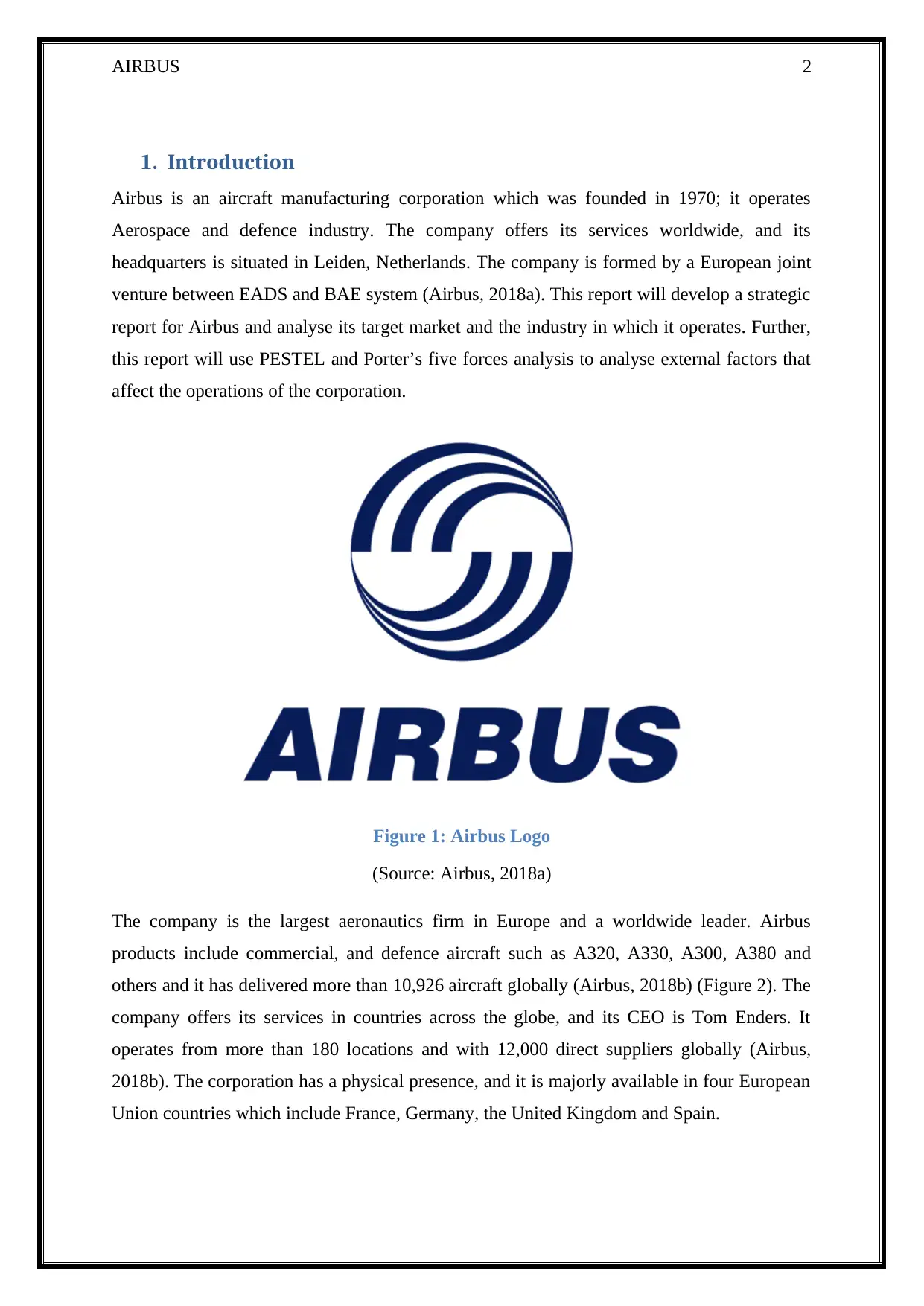
AIRBUS 2
1. Introduction
Airbus is an aircraft manufacturing corporation which was founded in 1970; it operates
Aerospace and defence industry. The company offers its services worldwide, and its
headquarters is situated in Leiden, Netherlands. The company is formed by a European joint
venture between EADS and BAE system (Airbus, 2018a). This report will develop a strategic
report for Airbus and analyse its target market and the industry in which it operates. Further,
this report will use PESTEL and Porter’s five forces analysis to analyse external factors that
affect the operations of the corporation.
Figure 1: Airbus Logo
(Source: Airbus, 2018a)
The company is the largest aeronautics firm in Europe and a worldwide leader. Airbus
products include commercial, and defence aircraft such as A320, A330, A300, A380 and
others and it has delivered more than 10,926 aircraft globally (Airbus, 2018b) (Figure 2). The
company offers its services in countries across the globe, and its CEO is Tom Enders. It
operates from more than 180 locations and with 12,000 direct suppliers globally (Airbus,
2018b). The corporation has a physical presence, and it is majorly available in four European
Union countries which include France, Germany, the United Kingdom and Spain.
1. Introduction
Airbus is an aircraft manufacturing corporation which was founded in 1970; it operates
Aerospace and defence industry. The company offers its services worldwide, and its
headquarters is situated in Leiden, Netherlands. The company is formed by a European joint
venture between EADS and BAE system (Airbus, 2018a). This report will develop a strategic
report for Airbus and analyse its target market and the industry in which it operates. Further,
this report will use PESTEL and Porter’s five forces analysis to analyse external factors that
affect the operations of the corporation.
Figure 1: Airbus Logo
(Source: Airbus, 2018a)
The company is the largest aeronautics firm in Europe and a worldwide leader. Airbus
products include commercial, and defence aircraft such as A320, A330, A300, A380 and
others and it has delivered more than 10,926 aircraft globally (Airbus, 2018b) (Figure 2). The
company offers its services in countries across the globe, and its CEO is Tom Enders. It
operates from more than 180 locations and with 12,000 direct suppliers globally (Airbus,
2018b). The corporation has a physical presence, and it is majorly available in four European
Union countries which include France, Germany, the United Kingdom and Spain.
⊘ This is a preview!⊘
Do you want full access?
Subscribe today to unlock all pages.

Trusted by 1+ million students worldwide
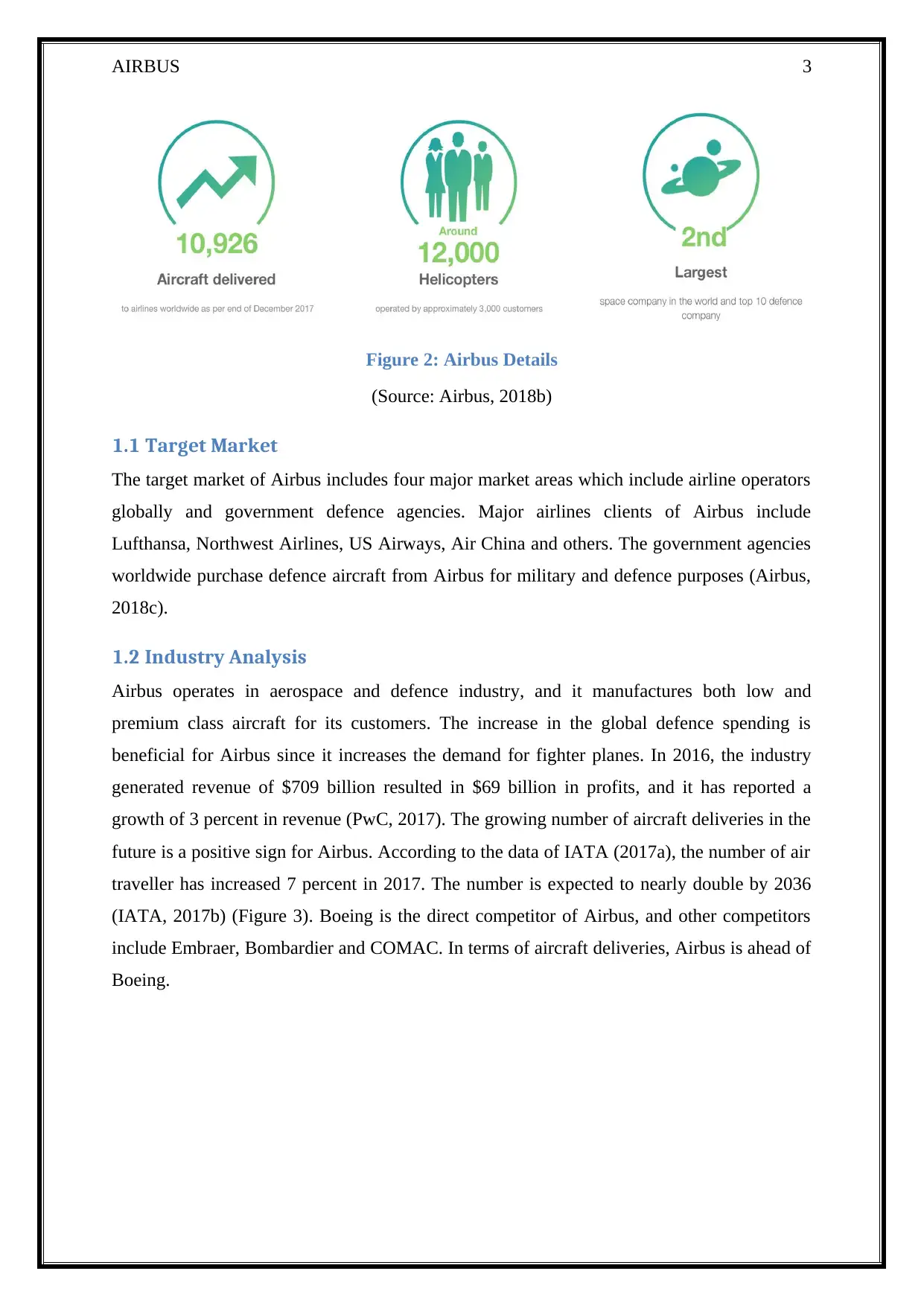
AIRBUS 3
Figure 2: Airbus Details
(Source: Airbus, 2018b)
1.1 Target Market
The target market of Airbus includes four major market areas which include airline operators
globally and government defence agencies. Major airlines clients of Airbus include
Lufthansa, Northwest Airlines, US Airways, Air China and others. The government agencies
worldwide purchase defence aircraft from Airbus for military and defence purposes (Airbus,
2018c).
1.2 Industry Analysis
Airbus operates in aerospace and defence industry, and it manufactures both low and
premium class aircraft for its customers. The increase in the global defence spending is
beneficial for Airbus since it increases the demand for fighter planes. In 2016, the industry
generated revenue of $709 billion resulted in $69 billion in profits, and it has reported a
growth of 3 percent in revenue (PwC, 2017). The growing number of aircraft deliveries in the
future is a positive sign for Airbus. According to the data of IATA (2017a), the number of air
traveller has increased 7 percent in 2017. The number is expected to nearly double by 2036
(IATA, 2017b) (Figure 3). Boeing is the direct competitor of Airbus, and other competitors
include Embraer, Bombardier and COMAC. In terms of aircraft deliveries, Airbus is ahead of
Boeing.
Figure 2: Airbus Details
(Source: Airbus, 2018b)
1.1 Target Market
The target market of Airbus includes four major market areas which include airline operators
globally and government defence agencies. Major airlines clients of Airbus include
Lufthansa, Northwest Airlines, US Airways, Air China and others. The government agencies
worldwide purchase defence aircraft from Airbus for military and defence purposes (Airbus,
2018c).
1.2 Industry Analysis
Airbus operates in aerospace and defence industry, and it manufactures both low and
premium class aircraft for its customers. The increase in the global defence spending is
beneficial for Airbus since it increases the demand for fighter planes. In 2016, the industry
generated revenue of $709 billion resulted in $69 billion in profits, and it has reported a
growth of 3 percent in revenue (PwC, 2017). The growing number of aircraft deliveries in the
future is a positive sign for Airbus. According to the data of IATA (2017a), the number of air
traveller has increased 7 percent in 2017. The number is expected to nearly double by 2036
(IATA, 2017b) (Figure 3). Boeing is the direct competitor of Airbus, and other competitors
include Embraer, Bombardier and COMAC. In terms of aircraft deliveries, Airbus is ahead of
Boeing.
Paraphrase This Document
Need a fresh take? Get an instant paraphrase of this document with our AI Paraphraser
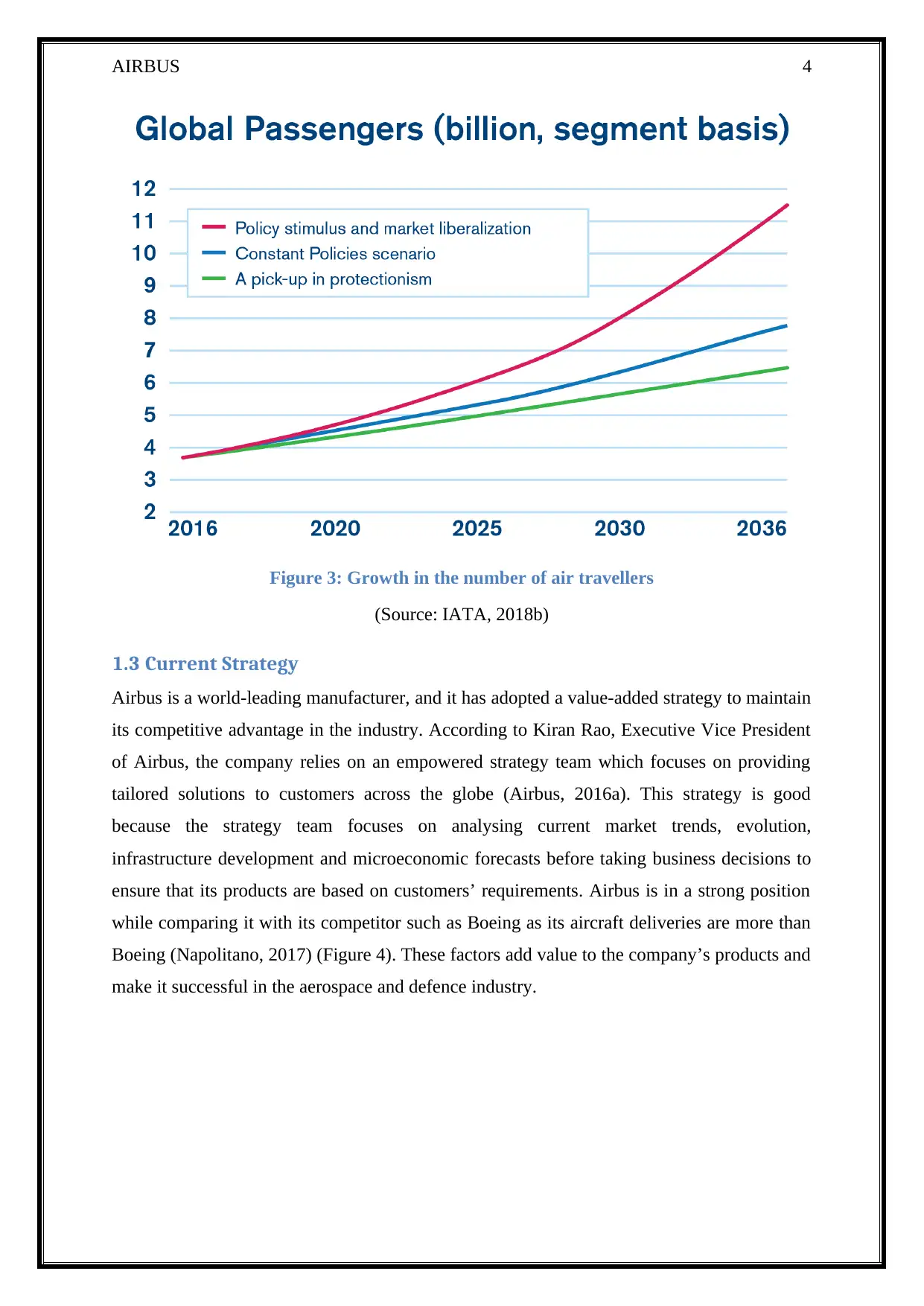
AIRBUS 4
Figure 3: Growth in the number of air travellers
(Source: IATA, 2018b)
1.3 Current Strategy
Airbus is a world-leading manufacturer, and it has adopted a value-added strategy to maintain
its competitive advantage in the industry. According to Kiran Rao, Executive Vice President
of Airbus, the company relies on an empowered strategy team which focuses on providing
tailored solutions to customers across the globe (Airbus, 2016a). This strategy is good
because the strategy team focuses on analysing current market trends, evolution,
infrastructure development and microeconomic forecasts before taking business decisions to
ensure that its products are based on customers’ requirements. Airbus is in a strong position
while comparing it with its competitor such as Boeing as its aircraft deliveries are more than
Boeing (Napolitano, 2017) (Figure 4). These factors add value to the company’s products and
make it successful in the aerospace and defence industry.
Figure 3: Growth in the number of air travellers
(Source: IATA, 2018b)
1.3 Current Strategy
Airbus is a world-leading manufacturer, and it has adopted a value-added strategy to maintain
its competitive advantage in the industry. According to Kiran Rao, Executive Vice President
of Airbus, the company relies on an empowered strategy team which focuses on providing
tailored solutions to customers across the globe (Airbus, 2016a). This strategy is good
because the strategy team focuses on analysing current market trends, evolution,
infrastructure development and microeconomic forecasts before taking business decisions to
ensure that its products are based on customers’ requirements. Airbus is in a strong position
while comparing it with its competitor such as Boeing as its aircraft deliveries are more than
Boeing (Napolitano, 2017) (Figure 4). These factors add value to the company’s products and
make it successful in the aerospace and defence industry.
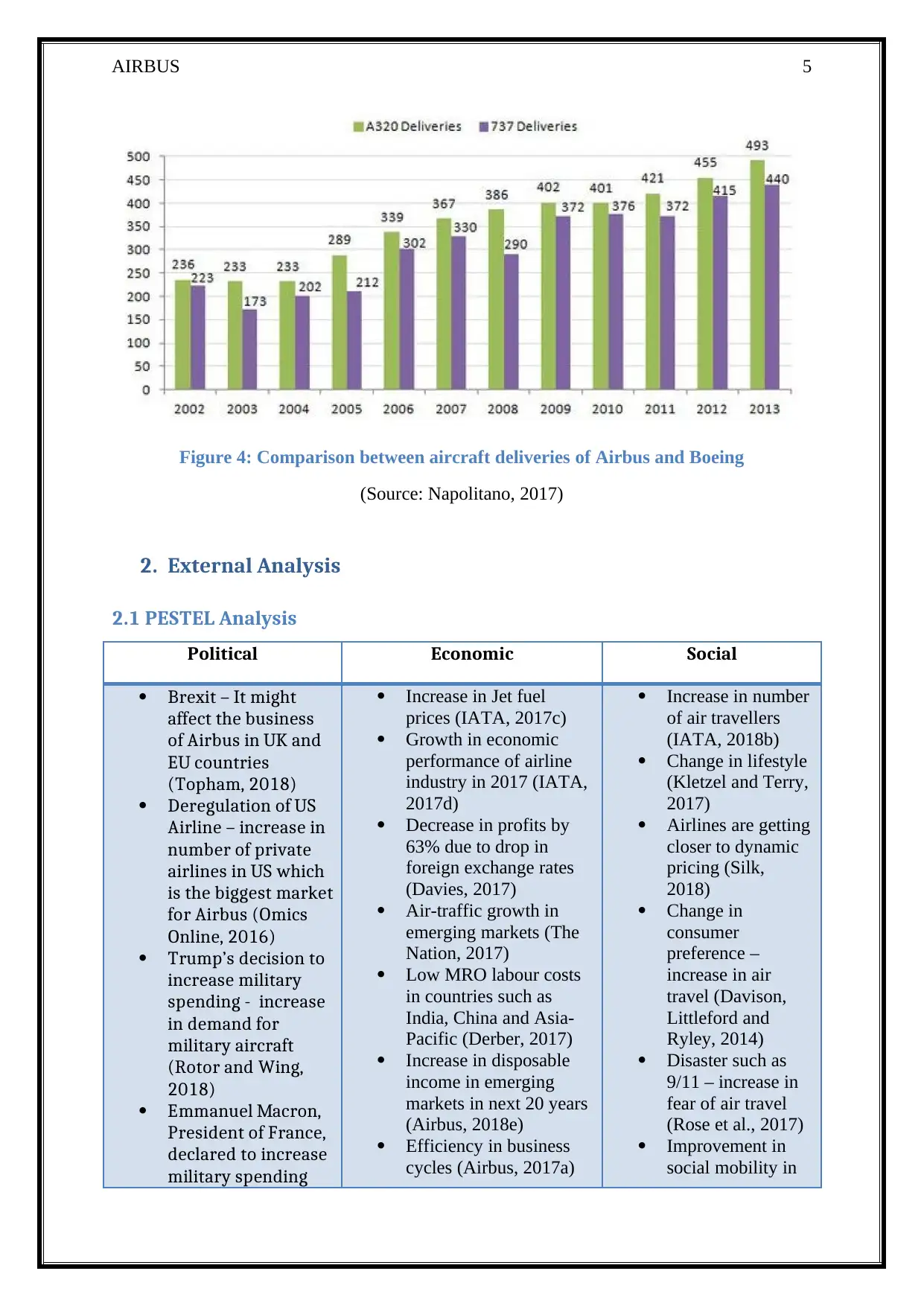
AIRBUS 5
Figure 4: Comparison between aircraft deliveries of Airbus and Boeing
(Source: Napolitano, 2017)
2. External Analysis
2.1 PESTEL Analysis
Political Economic Social
Brexit – It might
affect the business
of Airbus in UK and
EU countries
(Topham, 2018)
Deregulation of US
Airline – increase in
number of private
airlines in US which
is the biggest market
for Airbus (Omics
Online, 2016)
Trump’s decision to
increase military
spending - increase
in demand for
military aircraft
(Rotor and Wing,
2018)
Emmanuel Macron,
President of France,
declared to increase
military spending
Increase in Jet fuel
prices (IATA, 2017c)
Growth in economic
performance of airline
industry in 2017 (IATA,
2017d)
Decrease in profits by
63% due to drop in
foreign exchange rates
(Davies, 2017)
Air-traffic growth in
emerging markets (The
Nation, 2017)
Low MRO labour costs
in countries such as
India, China and Asia-
Pacific (Derber, 2017)
Increase in disposable
income in emerging
markets in next 20 years
(Airbus, 2018e)
Efficiency in business
cycles (Airbus, 2017a)
Increase in number
of air travellers
(IATA, 2018b)
Change in lifestyle
(Kletzel and Terry,
2017)
Airlines are getting
closer to dynamic
pricing (Silk,
2018)
Change in
consumer
preference –
increase in air
travel (Davison,
Littleford and
Ryley, 2014)
Disaster such as
9/11 – increase in
fear of air travel
(Rose et al., 2017)
Improvement in
social mobility in
Figure 4: Comparison between aircraft deliveries of Airbus and Boeing
(Source: Napolitano, 2017)
2. External Analysis
2.1 PESTEL Analysis
Political Economic Social
Brexit – It might
affect the business
of Airbus in UK and
EU countries
(Topham, 2018)
Deregulation of US
Airline – increase in
number of private
airlines in US which
is the biggest market
for Airbus (Omics
Online, 2016)
Trump’s decision to
increase military
spending - increase
in demand for
military aircraft
(Rotor and Wing,
2018)
Emmanuel Macron,
President of France,
declared to increase
military spending
Increase in Jet fuel
prices (IATA, 2017c)
Growth in economic
performance of airline
industry in 2017 (IATA,
2017d)
Decrease in profits by
63% due to drop in
foreign exchange rates
(Davies, 2017)
Air-traffic growth in
emerging markets (The
Nation, 2017)
Low MRO labour costs
in countries such as
India, China and Asia-
Pacific (Derber, 2017)
Increase in disposable
income in emerging
markets in next 20 years
(Airbus, 2018e)
Efficiency in business
cycles (Airbus, 2017a)
Increase in number
of air travellers
(IATA, 2018b)
Change in lifestyle
(Kletzel and Terry,
2017)
Airlines are getting
closer to dynamic
pricing (Silk,
2018)
Change in
consumer
preference –
increase in air
travel (Davison,
Littleford and
Ryley, 2014)
Disaster such as
9/11 – increase in
fear of air travel
(Rose et al., 2017)
Improvement in
social mobility in
⊘ This is a preview!⊘
Do you want full access?
Subscribe today to unlock all pages.

Trusted by 1+ million students worldwide

AIRBUS 6
(Chassany, 2018)
Increase in terror
attacks – with ISIS
and al-Qaeda
(Turak, 2017)
Liberalisation of
trade between US
and EU creates new
opportunities for
Airbus (Mawby,
2017)
Payment of €81
million by Airbus to
end German
corruption probe
(The Local, 2018)
Tax deductions in
France (Altmeyer,
2016)
Repayment to
government
investors for
development of
poorly selling A380
(Tovey, 2017)
French and German
Governments
decision to replace
the top management
of Airbus (Briganti,
2017)
Competitors pricing
strategy (Zhang, 2016)
Duopoly between Airbus
and Boeing (Pearlstein,
2018)
Increase in
unemployment (Reuters,
2018)
Europe (Sanders,
2013)
Changing attitude
towards quality
and customer
service (Wang, Lin
and Tseng, 2011)
Increase in number
of airline operators
(IATA, 2017c)
Attitude towards
green products and
changing airline
industry (Davies,
2018)
Highest growth in
tourism in past
seven years
(UNWTO, 2018)
Technological Environmental Legal
Increase in research
funding from Airbus
(Hughes, 2016)
Development in
Information
technology (IT) in
passenger aircraft
(Airbus, 2018f)
Use of new materials
in aircraft
manufacturing
(Standridge, 2014)
Use of Robotics in
Dividing global air
traffic into regional
traffic flow (Azzam,
2017)
Monitoring of
pollution caused by
the company to
reduce its impact
(Greenbiz, 2014)
Use of eco-friendly
and eco-efficient
technologies (Airbus,
2015)
Reduction in waste by
Health and safety
employment laws
(Bourrier, 2017)
Restrictions on trade
laws (Mattoo and
Subramanian, 2009)
Claims of anti-
competitive behaviour
(Kirby, 2009)
Legal suit by three
companies over H225
situation (Johnson,
2016)
Alleged Eurofighter
(Chassany, 2018)
Increase in terror
attacks – with ISIS
and al-Qaeda
(Turak, 2017)
Liberalisation of
trade between US
and EU creates new
opportunities for
Airbus (Mawby,
2017)
Payment of €81
million by Airbus to
end German
corruption probe
(The Local, 2018)
Tax deductions in
France (Altmeyer,
2016)
Repayment to
government
investors for
development of
poorly selling A380
(Tovey, 2017)
French and German
Governments
decision to replace
the top management
of Airbus (Briganti,
2017)
Competitors pricing
strategy (Zhang, 2016)
Duopoly between Airbus
and Boeing (Pearlstein,
2018)
Increase in
unemployment (Reuters,
2018)
Europe (Sanders,
2013)
Changing attitude
towards quality
and customer
service (Wang, Lin
and Tseng, 2011)
Increase in number
of airline operators
(IATA, 2017c)
Attitude towards
green products and
changing airline
industry (Davies,
2018)
Highest growth in
tourism in past
seven years
(UNWTO, 2018)
Technological Environmental Legal
Increase in research
funding from Airbus
(Hughes, 2016)
Development in
Information
technology (IT) in
passenger aircraft
(Airbus, 2018f)
Use of new materials
in aircraft
manufacturing
(Standridge, 2014)
Use of Robotics in
Dividing global air
traffic into regional
traffic flow (Azzam,
2017)
Monitoring of
pollution caused by
the company to
reduce its impact
(Greenbiz, 2014)
Use of eco-friendly
and eco-efficient
technologies (Airbus,
2015)
Reduction in waste by
Health and safety
employment laws
(Bourrier, 2017)
Restrictions on trade
laws (Mattoo and
Subramanian, 2009)
Claims of anti-
competitive behaviour
(Kirby, 2009)
Legal suit by three
companies over H225
situation (Johnson,
2016)
Alleged Eurofighter
Paraphrase This Document
Need a fresh take? Get an instant paraphrase of this document with our AI Paraphraser

AIRBUS 7
Aircraft
manufacturing
(Anandan, 2016)
Improvement in
security technology
such as SSL (secure
sockets layer
protocol
mechanism)
(Sampigethaya,
Poovendran and
Bushnell, 2008)
Presence in online
marketing (Digital
Training Academy,
2018)
Positive influence of
social media
presence (Garcia,
2016)
Alternative
resources to
substitute oil due to
the prices (Wee,
2012)
Advancement in
aerospace materials
(Airbus, 2016c)
Effective technology
to reduce
environmental
impact (HBS, 2016)
improving production
process (Airbus,
2014)
Airbus is leading the
way in reducing
airline noise pollution
(Southampton, 2018)
Reducing the impact
of climate change
(Airbus, 2018g)
Reducing liquid
hydrogen-fuelled
aircraft (Svensson,
Hasselrot and
Moldanova, 2004)
Use of modern
technology to reduce
environmental impact
(HBS, 2016)
Improvement of
security due to
adverse weather
condition (UPRT,
2017)
Alternative options
for fuel to reduce
environmental impact
(Wee, 2012)
fraud suit by Austria
(Knolle and Schwarz,
2017)
Legal conflict with
the government of
Japan (Lewis, 2015)
11 Families sued
Airbus for negligence
due to AirAsia crash
(Chan, 2015)
Case of negligence by
Air Canada over
Halifax crash landing
(CBC, 2017)
Resolution of lawsuit
against Boeing
(Gates, 2018)
Airbus sues Leonardo
for unfair trading
(Judson, 2018)
Political
Brexit is referred to an abbreviation for “British exit” which is referred to the decision of the
United Kingdom to leave the European Union (EU) which was taken on June 23, 2016. The
tread takes place in the United Kingdom and Europe; however, it affected industries across
the globe. This trend started from June 23, 2016, and it is likely to affect next ten years of
corporations situated in the UK and European Union nations. Brexit has a significant impact
on the aerospace and defence industry. As per the study of Deloitte (2017), the regulatory
bodies operating in the industry such as European Open Skies regime (ECAA) and European
Safety Agency (EASA) ceased to exist after the Brexit. The EASA is one of the primary rules
making authority which provides guidelines for corporations operating in the UK and EU
Aircraft
manufacturing
(Anandan, 2016)
Improvement in
security technology
such as SSL (secure
sockets layer
protocol
mechanism)
(Sampigethaya,
Poovendran and
Bushnell, 2008)
Presence in online
marketing (Digital
Training Academy,
2018)
Positive influence of
social media
presence (Garcia,
2016)
Alternative
resources to
substitute oil due to
the prices (Wee,
2012)
Advancement in
aerospace materials
(Airbus, 2016c)
Effective technology
to reduce
environmental
impact (HBS, 2016)
improving production
process (Airbus,
2014)
Airbus is leading the
way in reducing
airline noise pollution
(Southampton, 2018)
Reducing the impact
of climate change
(Airbus, 2018g)
Reducing liquid
hydrogen-fuelled
aircraft (Svensson,
Hasselrot and
Moldanova, 2004)
Use of modern
technology to reduce
environmental impact
(HBS, 2016)
Improvement of
security due to
adverse weather
condition (UPRT,
2017)
Alternative options
for fuel to reduce
environmental impact
(Wee, 2012)
fraud suit by Austria
(Knolle and Schwarz,
2017)
Legal conflict with
the government of
Japan (Lewis, 2015)
11 Families sued
Airbus for negligence
due to AirAsia crash
(Chan, 2015)
Case of negligence by
Air Canada over
Halifax crash landing
(CBC, 2017)
Resolution of lawsuit
against Boeing
(Gates, 2018)
Airbus sues Leonardo
for unfair trading
(Judson, 2018)
Political
Brexit is referred to an abbreviation for “British exit” which is referred to the decision of the
United Kingdom to leave the European Union (EU) which was taken on June 23, 2016. The
tread takes place in the United Kingdom and Europe; however, it affected industries across
the globe. This trend started from June 23, 2016, and it is likely to affect next ten years of
corporations situated in the UK and European Union nations. Brexit has a significant impact
on the aerospace and defence industry. As per the study of Deloitte (2017), the regulatory
bodies operating in the industry such as European Open Skies regime (ECAA) and European
Safety Agency (EASA) ceased to exist after the Brexit. The EASA is one of the primary rules
making authority which provides guidelines for corporations operating in the UK and EU
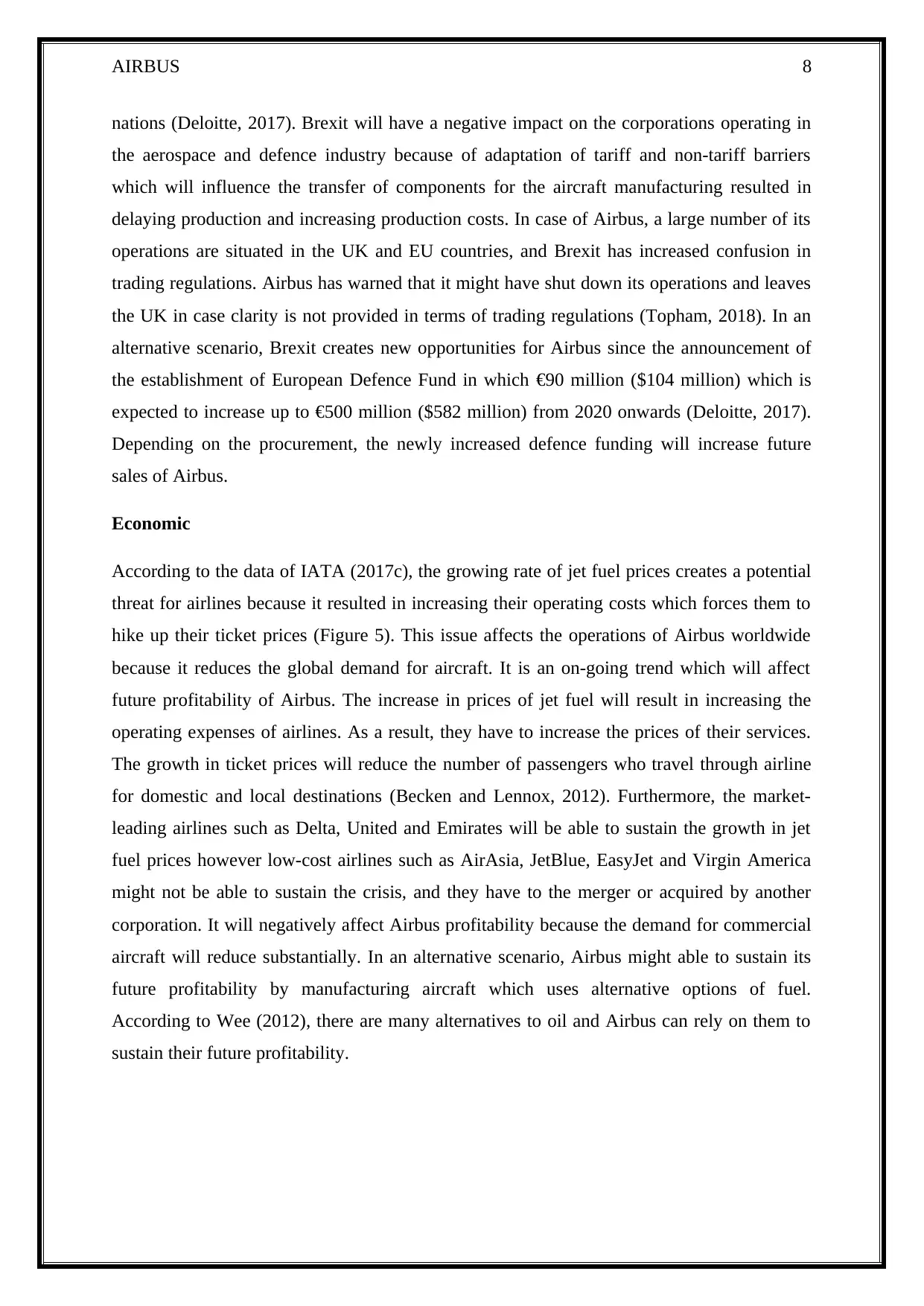
AIRBUS 8
nations (Deloitte, 2017). Brexit will have a negative impact on the corporations operating in
the aerospace and defence industry because of adaptation of tariff and non-tariff barriers
which will influence the transfer of components for the aircraft manufacturing resulted in
delaying production and increasing production costs. In case of Airbus, a large number of its
operations are situated in the UK and EU countries, and Brexit has increased confusion in
trading regulations. Airbus has warned that it might have shut down its operations and leaves
the UK in case clarity is not provided in terms of trading regulations (Topham, 2018). In an
alternative scenario, Brexit creates new opportunities for Airbus since the announcement of
the establishment of European Defence Fund in which €90 million ($104 million) which is
expected to increase up to €500 million ($582 million) from 2020 onwards (Deloitte, 2017).
Depending on the procurement, the newly increased defence funding will increase future
sales of Airbus.
Economic
According to the data of IATA (2017c), the growing rate of jet fuel prices creates a potential
threat for airlines because it resulted in increasing their operating costs which forces them to
hike up their ticket prices (Figure 5). This issue affects the operations of Airbus worldwide
because it reduces the global demand for aircraft. It is an on-going trend which will affect
future profitability of Airbus. The increase in prices of jet fuel will result in increasing the
operating expenses of airlines. As a result, they have to increase the prices of their services.
The growth in ticket prices will reduce the number of passengers who travel through airline
for domestic and local destinations (Becken and Lennox, 2012). Furthermore, the market-
leading airlines such as Delta, United and Emirates will be able to sustain the growth in jet
fuel prices however low-cost airlines such as AirAsia, JetBlue, EasyJet and Virgin America
might not be able to sustain the crisis, and they have to the merger or acquired by another
corporation. It will negatively affect Airbus profitability because the demand for commercial
aircraft will reduce substantially. In an alternative scenario, Airbus might able to sustain its
future profitability by manufacturing aircraft which uses alternative options of fuel.
According to Wee (2012), there are many alternatives to oil and Airbus can rely on them to
sustain their future profitability.
nations (Deloitte, 2017). Brexit will have a negative impact on the corporations operating in
the aerospace and defence industry because of adaptation of tariff and non-tariff barriers
which will influence the transfer of components for the aircraft manufacturing resulted in
delaying production and increasing production costs. In case of Airbus, a large number of its
operations are situated in the UK and EU countries, and Brexit has increased confusion in
trading regulations. Airbus has warned that it might have shut down its operations and leaves
the UK in case clarity is not provided in terms of trading regulations (Topham, 2018). In an
alternative scenario, Brexit creates new opportunities for Airbus since the announcement of
the establishment of European Defence Fund in which €90 million ($104 million) which is
expected to increase up to €500 million ($582 million) from 2020 onwards (Deloitte, 2017).
Depending on the procurement, the newly increased defence funding will increase future
sales of Airbus.
Economic
According to the data of IATA (2017c), the growing rate of jet fuel prices creates a potential
threat for airlines because it resulted in increasing their operating costs which forces them to
hike up their ticket prices (Figure 5). This issue affects the operations of Airbus worldwide
because it reduces the global demand for aircraft. It is an on-going trend which will affect
future profitability of Airbus. The increase in prices of jet fuel will result in increasing the
operating expenses of airlines. As a result, they have to increase the prices of their services.
The growth in ticket prices will reduce the number of passengers who travel through airline
for domestic and local destinations (Becken and Lennox, 2012). Furthermore, the market-
leading airlines such as Delta, United and Emirates will be able to sustain the growth in jet
fuel prices however low-cost airlines such as AirAsia, JetBlue, EasyJet and Virgin America
might not be able to sustain the crisis, and they have to the merger or acquired by another
corporation. It will negatively affect Airbus profitability because the demand for commercial
aircraft will reduce substantially. In an alternative scenario, Airbus might able to sustain its
future profitability by manufacturing aircraft which uses alternative options of fuel.
According to Wee (2012), there are many alternatives to oil and Airbus can rely on them to
sustain their future profitability.
⊘ This is a preview!⊘
Do you want full access?
Subscribe today to unlock all pages.

Trusted by 1+ million students worldwide

AIRBUS 9
Figure 5: Increasing Jet Fuel Price
(Source: IATA, 2017c)
Social
As per the study of Connor and Krogstad (2016), the immigrant share of the population in
many European countries jumped significantly with Sweden, Hungary and Austria receiving
most immigrants. Factors such as Brexit resulted in increasing the number of immigrant in
European nations because a total of 4.3 million people immigrated to EU member states in
2016 (Euro Stat, 2018). It is an on-going trend which will affect the profitability of the
aerospace industry in the UK and EU countries. The growth in number of immigrants creates
new business opportunities in the aerospace industry as the number of air travellers increases.
This trend can positively affect Airbus because the demand for commercial airlines increased
in EU countries which are the primary market for the company. The number of air traveller
will double by 2036 (IATA, 2017b). It will assist in increasing the market share of Airbus in
EU countries because it has already established effective manufacturing facilities in the
country. In an alternative scenario, it can result in increasing competition for Airbus and its
competitors, primarily Boeing, also evaluate these new business opportunities, and they
expand their operations in order to capture the EU aerospace industry.
Figure 5: Increasing Jet Fuel Price
(Source: IATA, 2017c)
Social
As per the study of Connor and Krogstad (2016), the immigrant share of the population in
many European countries jumped significantly with Sweden, Hungary and Austria receiving
most immigrants. Factors such as Brexit resulted in increasing the number of immigrant in
European nations because a total of 4.3 million people immigrated to EU member states in
2016 (Euro Stat, 2018). It is an on-going trend which will affect the profitability of the
aerospace industry in the UK and EU countries. The growth in number of immigrants creates
new business opportunities in the aerospace industry as the number of air travellers increases.
This trend can positively affect Airbus because the demand for commercial airlines increased
in EU countries which are the primary market for the company. The number of air traveller
will double by 2036 (IATA, 2017b). It will assist in increasing the market share of Airbus in
EU countries because it has already established effective manufacturing facilities in the
country. In an alternative scenario, it can result in increasing competition for Airbus and its
competitors, primarily Boeing, also evaluate these new business opportunities, and they
expand their operations in order to capture the EU aerospace industry.
Paraphrase This Document
Need a fresh take? Get an instant paraphrase of this document with our AI Paraphraser

AIRBUS 10
2.2 Five Forces Framework
The buyers of Airbus include premium and low-cost airlines such as Lufthansa, Northwest
Airlines, US Airways, Air China, Jet Airways, and Qatar Airways, private jet companies and
government defence agencies (Airbus, 2018c). These airlines purchase aircraft from
competitors of Airbus as well such as Boeing. The suppliers of Airbus include fabrics
suppliers, steel and metal manufacturers, fuel companies, engine manufacturers such as Rolls
Royce and Safran, and hardware and software manufacturers. These suppliers provide
services to competitors of Airbus as well.
Competitive Rivalry Medium to high
Supplier Power Low
Buyer Power Low
Threat of Substitution Low
Threat of New Entry Low
Supplier Power
The supplier power in aircraft manufacturing industry is low because there are a large number
of suppliers available in the sector and the corporations can easily switch between them. It
has a positive impact on the industry because Aircraft manufacturers such as Airbus and
Boeing receive quality services and products from their suppliers. It also easier for
organisations to implement change policies in the aircraft manufacturing industries because
suppliers have limited options, therefore, they have to comply with the regulations. The low
power of suppliers has a positive impact on Airbus because the company can expect its
suppliers to provide top-notch services and materials to the enterprise. Furthermore, due to
small options, the suppliers have to comply with new changes proposed by Airbus which is
beneficial for the company. For example, the company tells its A320 plane suppliers to cut
prices by 10 percent, and they have to follow the decision of the corporation because their
bargaining power is low (Hepher, 2015). This force is an opportunity for Airbus to
completely rely on its suppliers and create future business policies to avoid issues such as
delay in supplies, low-quality products and hike in prices. The corporation enters into an
agreement with its suppliers based on which they cannot increase the prices of their products
2.2 Five Forces Framework
The buyers of Airbus include premium and low-cost airlines such as Lufthansa, Northwest
Airlines, US Airways, Air China, Jet Airways, and Qatar Airways, private jet companies and
government defence agencies (Airbus, 2018c). These airlines purchase aircraft from
competitors of Airbus as well such as Boeing. The suppliers of Airbus include fabrics
suppliers, steel and metal manufacturers, fuel companies, engine manufacturers such as Rolls
Royce and Safran, and hardware and software manufacturers. These suppliers provide
services to competitors of Airbus as well.
Competitive Rivalry Medium to high
Supplier Power Low
Buyer Power Low
Threat of Substitution Low
Threat of New Entry Low
Supplier Power
The supplier power in aircraft manufacturing industry is low because there are a large number
of suppliers available in the sector and the corporations can easily switch between them. It
has a positive impact on the industry because Aircraft manufacturers such as Airbus and
Boeing receive quality services and products from their suppliers. It also easier for
organisations to implement change policies in the aircraft manufacturing industries because
suppliers have limited options, therefore, they have to comply with the regulations. The low
power of suppliers has a positive impact on Airbus because the company can expect its
suppliers to provide top-notch services and materials to the enterprise. Furthermore, due to
small options, the suppliers have to comply with new changes proposed by Airbus which is
beneficial for the company. For example, the company tells its A320 plane suppliers to cut
prices by 10 percent, and they have to follow the decision of the corporation because their
bargaining power is low (Hepher, 2015). This force is an opportunity for Airbus to
completely rely on its suppliers and create future business policies to avoid issues such as
delay in supplies, low-quality products and hike in prices. The corporation enters into an
agreement with its suppliers based on which they cannot increase the prices of their products

AIRBUS 11
and services due to the terms of the contract. Therefore, it has a positive impact on the
company.
Buyers Power
The buyer power in aircraft manufacturing industry is low because although there are six
major aircraft manufactures but Airbus and Boeing have created a duopoly in the sector
which reduces options for buyers. The low bargaining power of buyer has a positive impact
on the aircraft manufacturing sector because it is one of the most profitable sectors which
generate revenue of $709 billion in 2016. The low power of buyers has a positive impact on
Airbus since it has dominated the aircraft manufacturing industry along with Boeing
(Koenen, 2018). Both the corporations has established a duopoly in the sector based on which
they are the highest earning enterprises in the industry. The buyers in the industry have to
create a positive relationship with Airbus and Boeing because if they one rely on one aircraft
manufacturer then they can increase the prices of their products. This force creates a
significant opportunity for Airbus because the company is the primary aircraft manufacturer
and lack of option resulted in increasing its profitability. The company is one of the primary
earners in the aircraft manufacturing sectors along with Boeing, and it assists in sustaining its
profitability and future growth.
and services due to the terms of the contract. Therefore, it has a positive impact on the
company.
Buyers Power
The buyer power in aircraft manufacturing industry is low because although there are six
major aircraft manufactures but Airbus and Boeing have created a duopoly in the sector
which reduces options for buyers. The low bargaining power of buyer has a positive impact
on the aircraft manufacturing sector because it is one of the most profitable sectors which
generate revenue of $709 billion in 2016. The low power of buyers has a positive impact on
Airbus since it has dominated the aircraft manufacturing industry along with Boeing
(Koenen, 2018). Both the corporations has established a duopoly in the sector based on which
they are the highest earning enterprises in the industry. The buyers in the industry have to
create a positive relationship with Airbus and Boeing because if they one rely on one aircraft
manufacturer then they can increase the prices of their products. This force creates a
significant opportunity for Airbus because the company is the primary aircraft manufacturer
and lack of option resulted in increasing its profitability. The company is one of the primary
earners in the aircraft manufacturing sectors along with Boeing, and it assists in sustaining its
profitability and future growth.
⊘ This is a preview!⊘
Do you want full access?
Subscribe today to unlock all pages.

Trusted by 1+ million students worldwide
1 out of 22
Related Documents
Your All-in-One AI-Powered Toolkit for Academic Success.
+13062052269
info@desklib.com
Available 24*7 on WhatsApp / Email
![[object Object]](/_next/static/media/star-bottom.7253800d.svg)
Unlock your academic potential
Copyright © 2020–2025 A2Z Services. All Rights Reserved. Developed and managed by ZUCOL.




